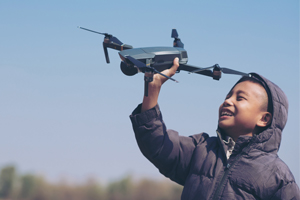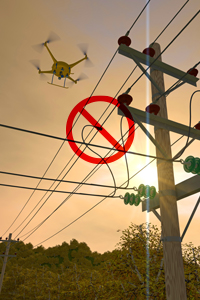
Drone Safety-SMART!
Whether children are new to drones or have lots of experience, knowing how to fly a drone safely is critical. Learn how to help children keep their drones from interfering in electric power lines and substations, and what to do if a drone goes where it shouldn’t.
You are the pilot of your drone
Just as an airplane pilot must keep his or her passengers safe, you must keep your drone safely away from areas where it could cause harm.
It is especially dangerous to fly drones near overhead power lines or electric substations.
 A drone that hits a high-voltage power line, transformer, or other electrical equipment can cause a power outage. Not only that, electricity from the lines or equipment can make the drone so hot it catches fire. From there, the fire can spread to nearby trees or buildings.
A drone that hits a high-voltage power line, transformer, or other electrical equipment can cause a power outage. Not only that, electricity from the lines or equipment can make the drone so hot it catches fire. From there, the fire can spread to nearby trees or buildings.
So always fly your drone in open areas, far away from power lines and substations.
This is extra important if it is windy. Drones are lightweight, and even if you think you’ve got one under control, gusts of wind can take your drone off course.
Remember: You are the pilot, and are in charge of keeping everyone safe while flying your drone.
Follow the Rules of the Sky
 The Federal Aviation Administration (FAA) is a United States government agency that sets and enforces rules for pilots. As the pilot of your drone, you must follow the FAA’s rules of the sky:
The Federal Aviation Administration (FAA) is a United States government agency that sets and enforces rules for pilots. As the pilot of your drone, you must follow the FAA’s rules of the sky:
- Drones weighing more than 0.55 pounds must be registered with the FAA. You must be at least 13 years old to register your drone. If you are under 13, a responsible adult must register in your place.
- To register your drone, visit faadronezone.faa.gov. Flying an unregistered drone is a crime and can result in large fines!
- Always keep your drone in sight.
- Do not fly near or over sensitive infrastructure or property. This includes electric power lines and substations, wind turbines, water treatment facilities, utility poles, trees, people or other aircraft, or within 5 miles of an airport.
- Do not fly near or over a wildfire. It’s against the law and firefighting aircraft could be grounded, disrupting time-critical firefighting efforts. Unauthorized flights near wildfires face civil penalties totaling more than $20,000.
- Do not fly after dark.
- Never fly higher than 400 feet.
- Do not fly in adverse weather conditions, such as high winds or reduced visibility.
Do not treat your drone as a toy or fly it recklessly. It is capable of causing damage and destruction if you crash it into utility poles, electric power lines, or trees near power lines.
Avoid the No-Drone Zone
 Experienced pilots use a checklist before they fly, so they don’t forget any safety rules. Here is your No-Drone Zone checklist for safe flying:
Experienced pilots use a checklist before they fly, so they don’t forget any safety rules. Here is your No-Drone Zone checklist for safe flying:
- Always fly your drone in an open area, where you can clearly see your drone and your sightlines.
- Never fly in windy weather or when there is thunder or lightning.
- Keep your drone away from trees and people.
- Never fly your drone over or into any of these:
- Electric power lines
- Utility poles
- Electric substations
- Water treatment facilities
- Wind Turbines
- Airports
- Other aircraft
- Wildfires

